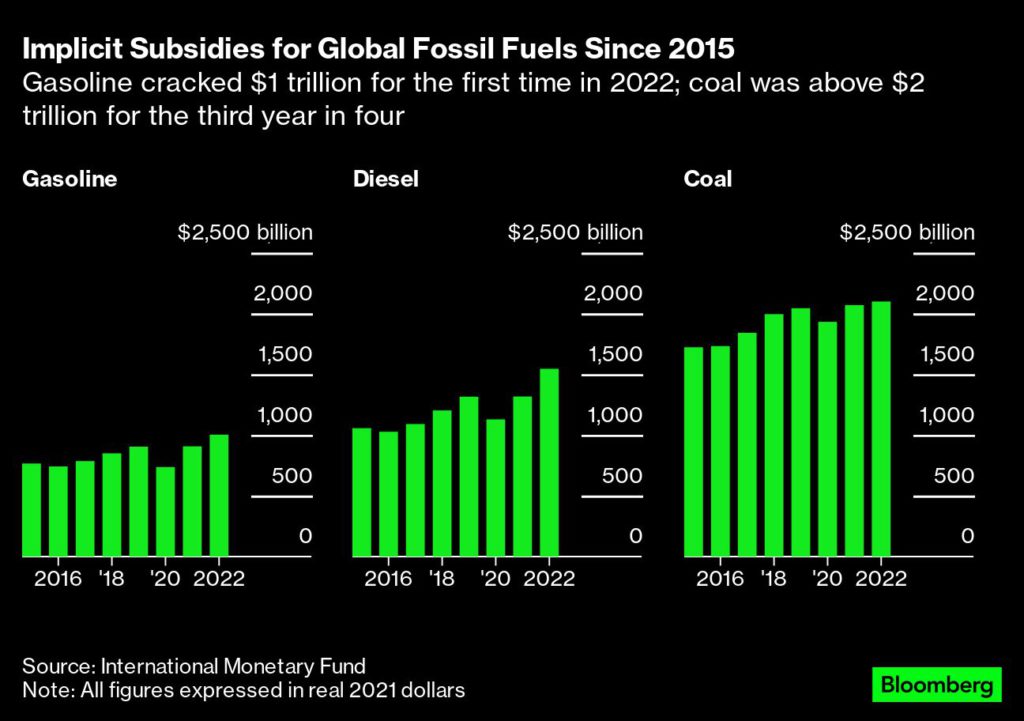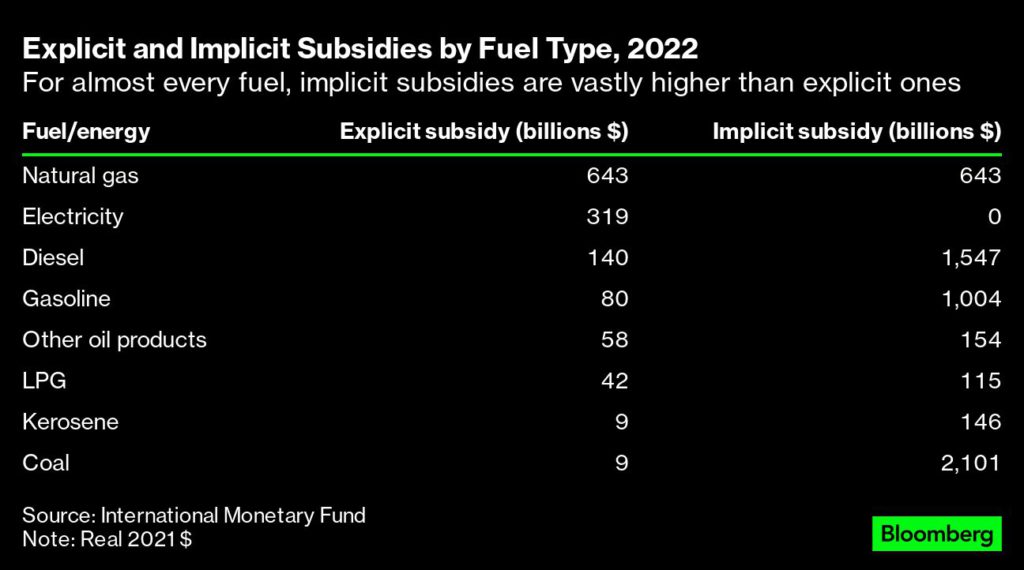The biggest fossil fuel subsidies are indirect, and bigger than ever

The world is headed for a record year of investment in the energy transition. Every new clean electron generated by wind turbines and solar arrays, and each new battery-powered car and hydrogen electrolyzer, will reduce some measure of the fossil fuels consumed on the planet’s roads and grids. More than $1 trillion was spent on the transition last year, and almost certainly will be spent again in 2023.
Big as that figure is, it pales in comparison to another energy-related outlay: subsidies for fossil fuels and electricity. The International Monetary Fund calculated that just over $7 trillion in subsidies went to fossil fuels last year. That is a record for at least the past decade. Since the IMF’s report expresses all figures in 2021 dollars, inflation cannot explain away the increase. In short, the world has never spent this much to subsidize fossil fuels.
About one-quarter of the total — $1.33 trillion — is made up of what the IMF terms explicit subsidies, or undercharging for the cost of supplying a fossil fuel or electricity. The figure is a record in its own right, and more that the total investment in the energy transition tracked last year by BloombergNEF.
But that still leaves a balance of $5.7 trillion in implicit subsidies, or undercharging for the environmental costs of a fuel, as well as forgone taxes on consumption. This amount is another record, and up 10% from 2021. Implicit subsidies grew less in percentage terms than explicit ones, but given their scale, they increased nearly as much in absolute terms — by more than $500 billion.
These subsidies aren’t just huge. They are also fairly predictable, unlike explicit subsidies, which vary significantly from year to year depending on fuel prices and government policy decisions. For instance, explicit subsidies declined by a quarter in 2016 and rose by 39% a year later. The years 2020 and 2021 are outliers due to Covid-19, but in this sense energy subsidies are hardly unique.
Last year, three fuels received more than a trillion dollars each in implicit supports. Gasoline got just over $1 trillion (for the first time); diesel, more than $1.5 trillion; and coal, $2.1 trillion — the third year since 2015 in which it received at least $2 trillion.

The difference between implicit and explicit subsidies for a given fuel (or electricity) can be significant. Gasoline receives “only” $80 billion in explicit terms, and diesel $140 billion; they receive, respectively, 11 and 12 times more in implicit terms. Kerosene gets an even greater implicit subsidy compared to its explicit one: $146 billion versus $9 billion.

There are some exceptions to this general pattern. Natural gas is the only fuel to receive less implicit than explicit subsidy. But with half a billion dollars separating more than $640 billion for both subsidy types for gas, calling them “equal” would be better. Electricity receives more than $300 billion in explicit dollars, according to the IMF, but zero implicit ones.
And then there is coal. Last year, coal received all of $8.6 billion in explicit subsidies and $2.1 trillion in implicit subsidies — a more than 240 times’ difference.
The IMF notes in its report that keeping fuel prices below their “fully efficient levels” also keeps greenhouse gas emissions high. Were the world to raise prices to the level that accounts for both their explicit and implicit costs, then carbon dioxide emissions from fossil fuels could fall more than 40% below their baseline levels (and a third lower than emissions in 2019) by the end of the decade.
Yet the very persistence of multi-trillion-dollar indirect subsidies suggests how hard such a move would be in practice. We may be inured to the cost of underpricing, even if it’s more than 5% of global gross domestic product.
The IMF’s data itself, though, also suggests a path toward reducing implicit subsidies without a coordinated global effort of raising prices to efficient levels. As noted above, only one energy source has zero implicit subsidy: electricity. It does have more than $300 billion of explicit subsidy, of course, but as an energy source, it does not carry with it the same implicit costs as kerosene, or coal.
That means that wherever electricity displaces another energy source, it is also reducing implicit subsidy. And at the same time, wherever that electricity is low-cost and renewable, it is reducing reliance on fossil fuels and their own fuel-based subsidies too. Electricity is an outlier in the world’s $7 trillion energy subsidy landscape, and that’s a good thing.
(By Nathaniel Bullard)
More News
{{ commodity.name }}
{{ post.title }}
{{ post.date }}



Comments